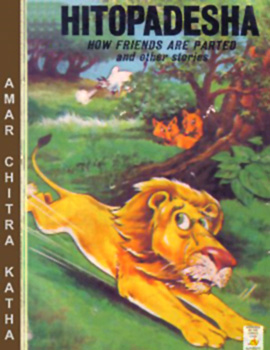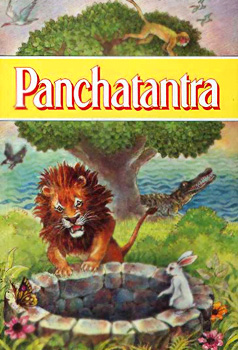 Indian legends are a large body of folklore, traditional stories and fables which are very popular among people. Noteworthy collections of Indian traditional stories include the Panchatantra, a collection of traditional narratives made by Vishnu Sharma in the second century BC. The Hitopadesha of Narayana is a collection of anthropomorphic fabliaux, animal fables, in Sanskrit, compiled in the ninth century. The Jataka tales also forms an important part of the Indian legends. The folktales are in fact a symbolic way of presenting the diverse means by which human beings deal with the world in which they live. These short stories concern people, either royalty or common folk or animals who speak and act like people.
Indian legends are a large body of folklore, traditional stories and fables which are very popular among people. Noteworthy collections of Indian traditional stories include the Panchatantra, a collection of traditional narratives made by Vishnu Sharma in the second century BC. The Hitopadesha of Narayana is a collection of anthropomorphic fabliaux, animal fables, in Sanskrit, compiled in the ninth century. The Jataka tales also forms an important part of the Indian legends. The folktales are in fact a symbolic way of presenting the diverse means by which human beings deal with the world in which they live. These short stories concern people, either royalty or common folk or animals who speak and act like people.
The Jataka tales were written in 300 B.C, for mankind to gain knowledge and ethics. The luminous fables of `Jataka` are intended to convey values of self-sacrifice, morality, honesty and other informative values to people. Jataka stories symbolise previous incarnations of Lord Buddha, at times like an animal, a bird and sometimes like a human being, the future Siddhartha Gautama. The setting of the stories is made in or near Benaras (Varanasi), which is a holy city in north central India. Each story in the Jataka tales comes with a moral, for example, the story of the golden swan instructs that greed brings nothing and people should be content with what they have. The Talkative tortoise is another interesting story from the Jataka tales which preaches against the pitfalls of talking too much. The tale of the Penny Wise monkey explains the importance to value things that one have. Other stories from the album of Jataka Tales are Cunning Wolf, Wind and Moon and Power of a Rumour.
 The Hitopadesha is a noteworthy compilation of short stories. It was composed by Narayana Pandit. In Indian literature Hitopadesha is regarded more or less analogous to the Panchatantra. The word `Hitopadesha` means `Hita` (welfare) and `Upadesha` (advice). As the term suggests, the Hitopadesha is a compilation of tales that advocate and advice for the welfare and benefit of everyone. Conveying morals and information, Hitopadesha is one among the most extensively read Sanskrit language book in India. The tales from Hitopadesha comes with a moral for instance the story of the Elephant and the Jackal teaches that every despot has to meet his doom. The story of the Donkey and the Dog instructs one to mind his own business. The interesting story of Old Tiger and Traveller preaches against the dangers of greed and that greed never goes unpunished. The story of the Rabbits and the Elephants depicts the triumph of wit over might. Thus Hitopadesha can be deemed as a moral guide for the readers.
The Hitopadesha is a noteworthy compilation of short stories. It was composed by Narayana Pandit. In Indian literature Hitopadesha is regarded more or less analogous to the Panchatantra. The word `Hitopadesha` means `Hita` (welfare) and `Upadesha` (advice). As the term suggests, the Hitopadesha is a compilation of tales that advocate and advice for the welfare and benefit of everyone. Conveying morals and information, Hitopadesha is one among the most extensively read Sanskrit language book in India. The tales from Hitopadesha comes with a moral for instance the story of the Elephant and the Jackal teaches that every despot has to meet his doom. The story of the Donkey and the Dog instructs one to mind his own business. The interesting story of Old Tiger and Traveller preaches against the dangers of greed and that greed never goes unpunished. The story of the Rabbits and the Elephants depicts the triumph of wit over might. Thus Hitopadesha can be deemed as a moral guide for the readers.
The Panchatantra is a legendary anthology of Indian short stories. It was composed in the 2nd century B.C, and is believed to be written by Vishnu Sharma along with many other scholars. The idea behind the work was to instill moral values among the readers. The grand assortment has extraordinary tales that are liked and loved by people of every age group. The Panchatantra is the best guide to implant moral values in children since its each tale has a moral lesson in its end. The etymology of the word `Panchatantra` is an amalgamation of two words, `Pancha` (five) and `Tantra` (principle). So, the five principles or practices demonstrated by Panchatantra are `Mitra Bhedha` (Loss of Friends), `Mitra Laabha` (Gaining Friends), `Suhrudbheda` (Causing conflict between Friends), `Vigraha` (Separation) and `Sandhi` (Union). The stories of Panchatantra are quite interesting. The story of the Blue Jackal depicts that the one who abandons one`s own folk would perish. Monkey and the Crocodile, Hunter and Doves, Heron and the Crab and the Foolish Lion Clever Rabbits are some of the popular stories from the album of Panchatantra.
Numerous written compilations of Indian folk tales have been in existence for more than a thousand years. Apart from the Jataka tales, Hitopadesha and Panchatantra there are also several stories which are very popular in India. Stories of Tenali Raman and Birbal are quite fascinating. Kathasaritsagara is another famous 11th century collection of Indian legends, fairy tales and folk tales.












